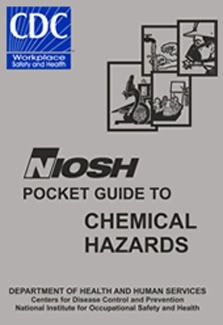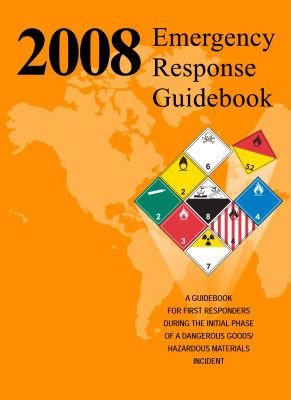Free Links for Online Access to NIOSH Database and 2008 ERG
My favorite chemical reference source is the NIOSH Pocket Guide to Chemical Hazards which is one of the key benchmarks in the chemical community for understanding the properties of hazardous materials. This reference source uses a non-biased scientifically based testing process to determine what the hazards are for a chemical is not influenced by the industry.

You can now access this data base for free by going on line to http://www.cdc.gov/niosh/npg/npgsyn-a.html or by clicking the link below.
http://www.cdc.gov/niosh/npg/npgsyn-a.html">NIOSH Pocket Guide t...
Once you get access to the NIOSH database, click on ammonia and note that the flammable range is listed as 15-28%, which by definition makes it a flammable gas. Look online at most of the available MSDS data sheets and they will still be showing the bogus, industry driven 16-25% flammable range which puts the flammable range at only 9% verses the more accurate 13% range which by definition makes it a flammable gas. Recent literature documents that ammonia's flammable range could drop down to as low as 8% when hydrocarbons from compressors get added into the equation.
Cold storage facilities that use anhydrous ammonia needs to be treated as a facility that uses a flammable gas. To not design and construct these facilities using these standards ensures the future for more tragedy and losses, with firefighters being on the short end of the stick. In the meantime, if you have not already changed your tactics and mindset as to the hidden hazards here, you have now been educated and should use extreme caution in the future by preplanning facilities, and ensuring that you have a way to determine LEL/UEL and concentrations. Cutting power is the number one consideration to prevent the chance of sparks. In many cases, by simply taking advantage of positive pressure ventilation techniques, the escaped ammonia can be diluted to the point where there is no longer a hazard or threat.
NH3 Cold storage facilities that I have helped design have passive detection systems that initiate ventilation fans that provide a minimum of 1 cubic foot of air moving for every 1 cubic foot of floor area. Additionally, a lighting system is provided on the corners of buildings using the NFPA 704 hazard colors as the guideline.
If you have a health hazard of 3 or greater, then a blue colored strobe light is mounted in a location that responding apparatus will have a clear view of, and preferable from a distance.
If you have flammable liquid or gas which are always a hazard ranking of 4 as well as some combustibles that have a ranking of 3, you would use a red strobe light.
If you have an unstable reactive material that has to be kept colder than 45˚F or it will spontaneously detonate... you would want to use a yellow strobe light to indicate that there is a problem...
Not sure if this is a new concept for any of you but when preplanning and meeting with the businesses, these are some additional safeguards that you can use to help mitigate the incident.
Please remember that MSDS data sheets are written by industry to comply with federal laws. No one is telling industry to reference the most recent testing procedures for determining whether ammonia is or is not flammable. If industry admits to this, it will cost them thousands of dollars in electrical and building upgrades for the more stringent building and electrical code requirements for flammable gases. Why would they want to do that.
So if you respond to a fixed facility incident involving anhydrous ammonia, please remember that you cannot reference the ERG emergency response guidebook for a fixed facility response. When ammonia is released from it's container, there is a distinct possibility that there could be an intimate mixing of ambient air with the ammonia to create the perfect storm for the mixture. If there is an ignition source, there WILL be an explosion and there has been several incidents over the years to substantiate this fact.

If you are dealing with an ammonia spill outside, involving a highway or rail vehicle or approved DOT container, then it is very appropriate to use the latest ERG. Don't have it yet? Here's where you can download a PDF file to have your own copy of the 2008 ERG:
http://hazmat.dot.gov/pubs/erg/erg2008_eng.pdf or click here.
If you would like to get a copy of the ERG in Spanish as well as other formats, go to this website:
http://hazmat.dot.gov/pubs/erg/gydebook.htm or click here.

You can now access this data base for free by going on line to http://www.cdc.gov/niosh/npg/npgsyn-a.html or by clicking the link below.
http://www.cdc.gov/niosh/npg/npgsyn-a.html">NIOSH Pocket Guide t...
Once you get access to the NIOSH database, click on ammonia and note that the flammable range is listed as 15-28%, which by definition makes it a flammable gas. Look online at most of the available MSDS data sheets and they will still be showing the bogus, industry driven 16-25% flammable range which puts the flammable range at only 9% verses the more accurate 13% range which by definition makes it a flammable gas. Recent literature documents that ammonia's flammable range could drop down to as low as 8% when hydrocarbons from compressors get added into the equation.
Cold storage facilities that use anhydrous ammonia needs to be treated as a facility that uses a flammable gas. To not design and construct these facilities using these standards ensures the future for more tragedy and losses, with firefighters being on the short end of the stick. In the meantime, if you have not already changed your tactics and mindset as to the hidden hazards here, you have now been educated and should use extreme caution in the future by preplanning facilities, and ensuring that you have a way to determine LEL/UEL and concentrations. Cutting power is the number one consideration to prevent the chance of sparks. In many cases, by simply taking advantage of positive pressure ventilation techniques, the escaped ammonia can be diluted to the point where there is no longer a hazard or threat.
NH3 Cold storage facilities that I have helped design have passive detection systems that initiate ventilation fans that provide a minimum of 1 cubic foot of air moving for every 1 cubic foot of floor area. Additionally, a lighting system is provided on the corners of buildings using the NFPA 704 hazard colors as the guideline.
If you have a health hazard of 3 or greater, then a blue colored strobe light is mounted in a location that responding apparatus will have a clear view of, and preferable from a distance.
If you have flammable liquid or gas which are always a hazard ranking of 4 as well as some combustibles that have a ranking of 3, you would use a red strobe light.
If you have an unstable reactive material that has to be kept colder than 45˚F or it will spontaneously detonate... you would want to use a yellow strobe light to indicate that there is a problem...
Not sure if this is a new concept for any of you but when preplanning and meeting with the businesses, these are some additional safeguards that you can use to help mitigate the incident.
Please remember that MSDS data sheets are written by industry to comply with federal laws. No one is telling industry to reference the most recent testing procedures for determining whether ammonia is or is not flammable. If industry admits to this, it will cost them thousands of dollars in electrical and building upgrades for the more stringent building and electrical code requirements for flammable gases. Why would they want to do that.
So if you respond to a fixed facility incident involving anhydrous ammonia, please remember that you cannot reference the ERG emergency response guidebook for a fixed facility response. When ammonia is released from it's container, there is a distinct possibility that there could be an intimate mixing of ambient air with the ammonia to create the perfect storm for the mixture. If there is an ignition source, there WILL be an explosion and there has been several incidents over the years to substantiate this fact.

If you are dealing with an ammonia spill outside, involving a highway or rail vehicle or approved DOT container, then it is very appropriate to use the latest ERG. Don't have it yet? Here's where you can download a PDF file to have your own copy of the 2008 ERG:
http://hazmat.dot.gov/pubs/erg/erg2008_eng.pdf or click here.
If you would like to get a copy of the ERG in Spanish as well as other formats, go to this website:
http://hazmat.dot.gov/pubs/erg/gydebook.htm or click here.
Tags:
Replies to This Discussion
-
Permalink Reply by Ben Waller on October 11, 2008 at 8:19am
-
Mike,
The most important part of the NFPA 704 diamond is the white section at the bottom, particularly when it has the "W" with the slash symbol.
My daughter tells me that this symbol means "No Wallers" so I shouldn't mess with those chemicals.
I can't argue with that one.
-
Permalink Reply by Engineco913 on October 11, 2008 at 6:05pm
-
Your daughters a smart gal. Tells you something when shes putting an eye on a DOT guidebook already. :)
Specialty Websites
Find Members Fast
Firefighting Videos
© 2025 Created by Firefighter Nation WebChief.
Powered by
![]()
Badges | Contact Firefighter Nation | Privacy Policy | Terms of Service